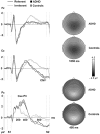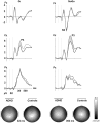ERP Correlates of Proactive and Reactive Cognitive Control in Treatment-Naïve Adult ADHD
- PMID: 27448275
- PMCID: PMC4957760
- DOI: 10.1371/journal.pone.0159833
ERP Correlates of Proactive and Reactive Cognitive Control in Treatment-Naïve Adult ADHD
Erratum in
-
Correction: ERP Correlates of Proactive and Reactive Cognitive Control in Treatment-Naïve Adult ADHD.PLoS One. 2016 Sep 15;11(9):e0163404. doi: 10.1371/journal.pone.0163404. eCollection 2016. PLoS One. 2016. PMID: 27631088 Free PMC article.
Abstract
This study investigated whether treatment naïve adults with Attention Deficit Hyperactivity Disorder (ADHD; n = 33; 19 female) differed from healthy controls (n = 31; 17 female) in behavioral performance, event-related potential (ERP) indices of preparatory attention (CueP3 and late CNV), and reactive response control (Go P3, NoGo N2, and NoGo P3) derived from a visual cued Go/NoGo task. On several critical measures, Cue P3, late CNV, and NoGo N2, there were no significant differences between the groups. This indicated normal preparatory processes and conflict monitoring in ADHD patients. However, the patients had attenuated Go P3 and NoGoP3 amplitudes relative to controls, suggesting reduced allocation of attentional resources to processes involved in response control. The patients also had a higher rate of Go signal omission errors, but no other performance decrements compared with controls. Reduced Go P3 and NoGo P3 amplitudes were associated with poorer task performance, particularly in the ADHD group. Notably, the ERPs were not associated with self-reported mood or anxiety. The results provide electrophysiological evidence for reduced effortful engagement of attentional resources to both Go and NoGo signals when reactive response control is needed. The absence of group differences in ERP components indexing proactive control points to impairments in specific aspects of cognitive processes in an untreated adult ADHD cohort. The associations between ERPs and task performance provided additional support for the altered electrophysiological responses.
Conflict of interest statement
Figures



Similar articles
-
Longitudinal Analysis of Self-Reported Symptoms, Behavioral Measures, and Event-Related Potential Components of a Cued Go/NoGo Task in Adults With Attention-Deficit/Hyperactivity Disorder and Controls.Front Hum Neurosci. 2022 Feb 18;16:767789. doi: 10.3389/fnhum.2022.767789. eCollection 2022. Front Hum Neurosci. 2022. PMID: 35250513 Free PMC article.
-
Attention and inhibition in children with ASD, ADHD and co-morbid ASD + ADHD: an event-related potential study.Psychol Med. 2014 Apr;44(5):1101-16. doi: 10.1017/S0033291713001049. Epub 2013 May 15. Psychol Med. 2014. PMID: 23673307
-
Information processing differences and similarities in adults with dyslexia and adults with Attention Deficit Hyperactivity Disorder during a Continuous Performance Test: a study of cortical potentials.Neuropsychologia. 2010 Aug;48(10):3045-56. doi: 10.1016/j.neuropsychologia.2010.06.014. Epub 2010 Jun 17. Neuropsychologia. 2010. PMID: 20600194
-
Genetics of preparation and response control in ADHD: the role of DRD4 and DAT1.J Child Psychol Psychiatry. 2014 Aug;55(8):914-23. doi: 10.1111/jcpp.12212. Epub 2014 Feb 13. J Child Psychol Psychiatry. 2014. PMID: 24521003
-
Emotional Processing and Attention Control Impairments in Children with Anxiety: An Integrative Review of Event-Related Potentials Findings.Front Psychol. 2016 May 3;7:562. doi: 10.3389/fpsyg.2016.00562. eCollection 2016. Front Psychol. 2016. PMID: 27199802 Free PMC article. Review.
Cited by
-
Slower adaptation of control strategies in individuals with high impulsive tendencies.Sci Rep. 2021 Oct 13;11(1):20368. doi: 10.1038/s41598-021-99764-1. Sci Rep. 2021. PMID: 34645922 Free PMC article. Clinical Trial.
-
Transcranial Alternating Current Stimulation (tACS) as a Tool to Modulate P300 Amplitude in Attention Deficit Hyperactivity Disorder (ADHD): Preliminary Findings.Brain Topogr. 2020 Mar;33(2):191-207. doi: 10.1007/s10548-020-00752-x. Epub 2020 Jan 23. Brain Topogr. 2020. PMID: 31974733 Free PMC article.
-
Shared and Disorder-Specific Event-Related Brain Oscillatory Markers of Attentional Dysfunction in ADHD and Bipolar Disorder.Brain Topogr. 2018 Jul;31(4):672-689. doi: 10.1007/s10548-018-0625-z. Epub 2018 Feb 7. Brain Topogr. 2018. PMID: 29417321 Free PMC article.
-
Longitudinal Analysis of Self-Reported Symptoms, Behavioral Measures, and Event-Related Potential Components of a Cued Go/NoGo Task in Adults With Attention-Deficit/Hyperactivity Disorder and Controls.Front Hum Neurosci. 2022 Feb 18;16:767789. doi: 10.3389/fnhum.2022.767789. eCollection 2022. Front Hum Neurosci. 2022. PMID: 35250513 Free PMC article.
-
DelIrium VULnerability in GEriatrics (DIVULGE) study: a protocol for a prospective observational study of electroencephalogram associations with incident postoperative delirium.BMJ Neurol Open. 2021 Dec 6;3(2):e000199. doi: 10.1136/bmjno-2021-000199. eCollection 2021. BMJ Neurol Open. 2021. PMID: 34964043 Free PMC article.
References
-
- Barkley RA, Fischer M, Smallish L, Fletcher K. The persistence of attention-deficit/hyperactivity disorder into young adulthood as a function of reporting source and definition of disorder. Journal of abnormal psychology. 2002;111(2):279–89. Epub 2002/05/11. . - PubMed
-
- Erskine HE, Ferrari AJ, Nelson P, Polanczyk GV, Flaxman AD, Vos T, et al. Research Review: Epidemiological modelling of attention-deficit/hyperactivity disorder and conduct disorder for the Global Burden of Disease Study 2010. Journal of child psychology and psychiatry, and allied disciplines. 2013;54(12):1263–74. 10.1111/jcpp.12144 . - DOI - PubMed
-
- Kessler RC, Adler L, Barkley R, Biederman J, Conners CK, Demler O, et al. The prevalence and correlates of adult ADHD in the United States: results from the National Comorbidity Survey Replication. The American journal of psychiatry. 2006;163(4):716–23. Epub 2006/04/06. 10.1176/appi.ajp.163.4.716 - DOI - PMC - PubMed
LinkOut - more resources
Full Text Sources
Other Literature Sources

